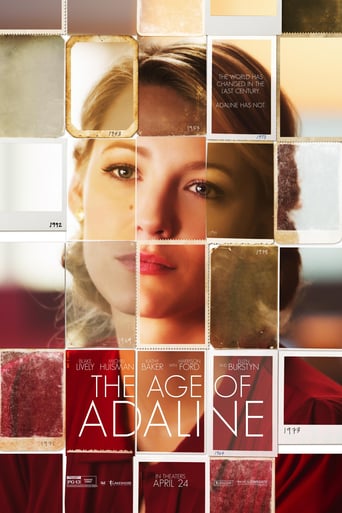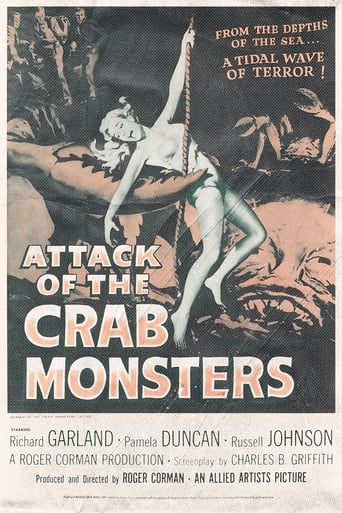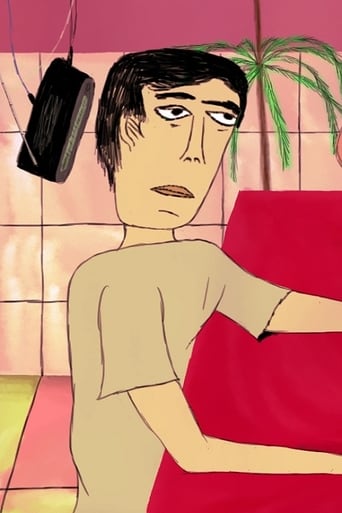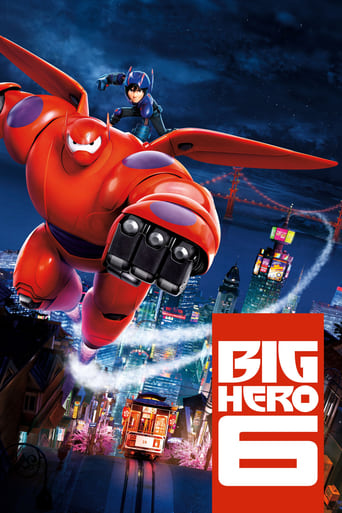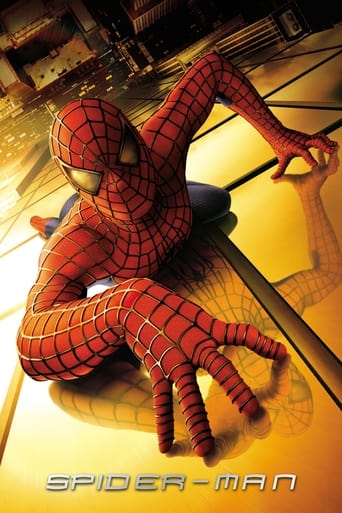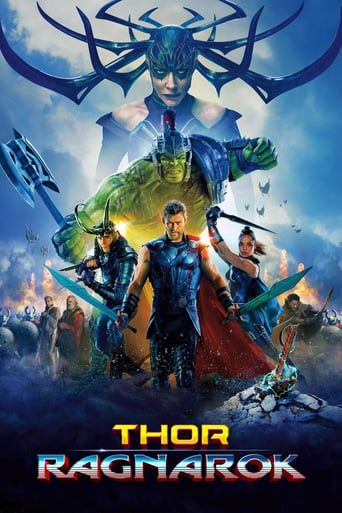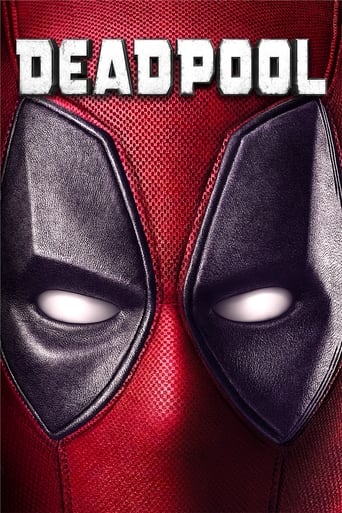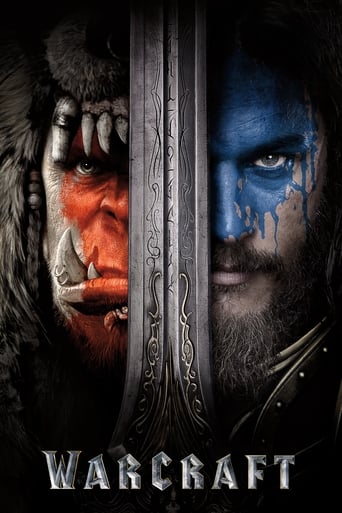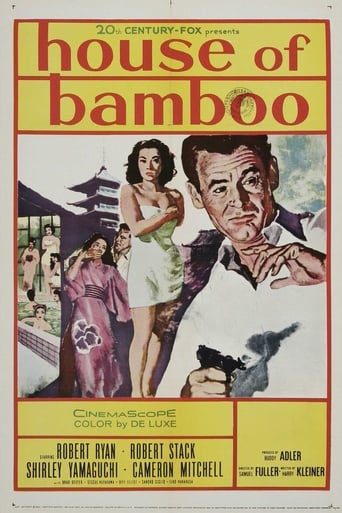


House of Bamboo
Eddie Kenner is given a special assignment by the Army to get the inside story on Sandy Dawson, a former GI who has formed a gang of fellow servicemen and Japanese locals.
-
- Cast:
- Robert Ryan , Robert Stack , Yoshiko Yamaguchi , Cameron Mitchell , Brad Dexter , Sessue Hayakawa , Biff Elliot


Similar titles
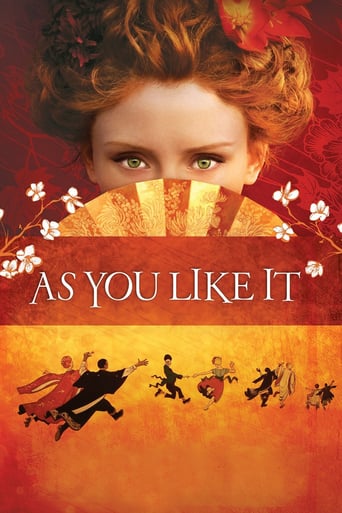
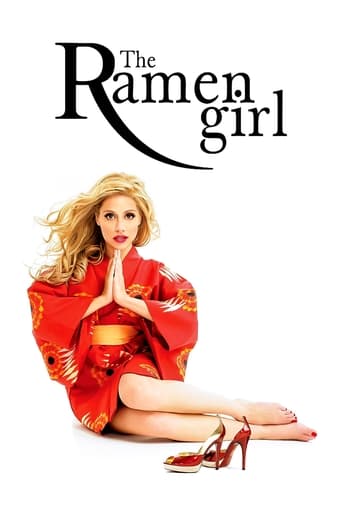

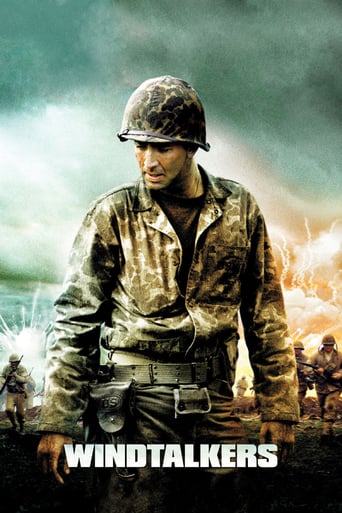
Reviews
Waste of time
I don't have all the words right now but this film is a work of art.
Beautiful, moving film.
Actress is magnificent and exudes a hypnotic screen presence in this affecting drama.
HOUSE OF BAMBOO 1955 This 20th Century Fox film, shot in Cinemascope is a loose remake of the same studios 1948 production, THE STREET WITH NO NAME. The cast includes, Robert Ryan, Robert Stack, Cameron Mitchell, Shirley Yamaguchi, Brad Dexter, Sessue Hayakawa and Deforest Kelly. The film is set in Japan and was shot on location.This one starts with a slick bit of robbery. An American military supply train travelling between Kyoto and Tokyo is held up and a supply of heavy machine guns and ammo lifted. The train's engine crew, and the military guards are killed. The Japanese Police and American MP's are called in to solve the case. Police Inspector, Hayakawa, and MP officer, Dexter, get nowhere fast trying to close the case.Several weeks later, a man, Biff Elliot, is brought in suffering from several bullet wounds. The bullets match those from the train robbery. Elliot had been left for dead by his gang during a thwarted robbery. The Police and the MP's question the man but he refuses to spill any info on the gang. He does however let slip that he is secretly married to Japanese woman, Shirley Yamaguchi.Next we have Robert Stack show up from the States. The man hunts up Yamaguchi and shows her a photo of her now dead husband and himself. He tells the woman that he is a longtime pal of the deceased hubby. (The photo is a faked up job) The whole thing is ploy by US Army Intelligence to get to the bottom of the arms robbery. Stack is undercover as a hood out to make some easy cash doing a protection racket bit. This soon draws the attention of just the people he is after. Robert Ryan and his group are making a fortune pulling robberies etc throughout Tokyo and surrounding area.Stack is soon asked to join said enterprise by Ryan. Cameron Mitchell and Deforest Kelly are the main members of the criminal crew. Mitchell takes an immediate dislike to Stack, which soon has the two coming to blows. Ryan has Stack doing collection and other easy jobs before having him join in a real heist.They hit a payroll office at a dockside factory. Guns are pulled, and several guards go down of severe lead poisoning, as does one of the gang. The gang has a rule about killing any gang member who gets wounded on a job. There is to be no one left behind to talk to the Police. Stack picks up a bullet but Ryan decides to break his own rule and grabs Stack up.Now the film becomes a game of cat and mouse as Stack uses Yamaguchi to help hide the fact that he is really a MP. Yamaguchi is seen passing info to Army MP, Dexter by gang member, Kelly. The gang though just thinks that the woman is having a bit on the side. When a robbery goes wrong, Ryan is sure there is a rat in the house. He wrongly picks Cameron Mitchell as the duplicitous rodent, and ventilates him.Ryan is soon put right by his newspaper reporter contact as to his error. Ryan now plans on mending his mistake, so he takes Stack and Kelly out on a robbery of a pearl seller. Once there, he lets Kelly in on Stack being an undercover man. They render Stack less than vertical, then, set him up with a gun and a pocket full of pearls. Ryan calls the Police and tells them there is a man with a gun at the shop. Ryan figures that the Police will show, see Stack with a gun and take care of Stack for him.The idea goes sideways when Stack regains his senses early. Then the Police show up quicker than Ryan had expected. Shots are fired and Ryan slips out a side door. The Police though are all over the building and Ryan is pursued to the roof. The roof is covered with an amusement park. A brisk chase over various rides etc is needed before Ryan is cornered. Ryan, handy with a gun, manages to drop several of the Police before Stack puts him down for the count.This one has some nice action scenes, particularly the opening train robbery. But, there are also several dead spots throughout the film. The colour Cinemascope vistas are nice, but work against any sort of gritty, film noir look. Some of the scenes come across as a bit too much travelogue like.Director Sam Fuller did better work on his earlier films like, THE STEEL HELMET, FIXED BAYONETS and in particular, PICKUP ON SOUTH STREET. Fuller, a personal favourite was a triple threat working as a writer and producer on some of his films. This is not a bad film, but it could have been better.The film was lensed by the talented Joe MacDonald. The 3 time Oscar nominated MacDonald was the cinematographer on, THE DARK CORNER, MY DARLING CLEMENTINE, THE STREET WITH NO NAME, YELLOW SKY, NIAGARA, WARLOCK, THE YOUNG LIONS, THE CARPETBAGGERS and THE SAND PEBBLES.The acting is quite good with Ryan in particular shining as the villain. Look close and you will see John Ford regular, Harry Carey Jr in a small unbilled part.
Some purists would insist that a film noir shot in colour is a contradiction in terms, but there were some American crime dramas from the fifties which had all the typical characteristics of noir apart from monochrome photography. Henry Hathaway's "Niagara" was one example, and Samuel Fuller's "House of Bamboo" is another. It is based upon the rather unlikely premise that an organised crime gang, consisting exclusively of white Americans, was operating in fifties Japan without the Japanese police suspecting who was responsible for the string of daring robberies they carried out. (The Yakuza, the traditional Japanese mafia, might also have had something to say about a gang of gaijin trying to muscle in on their turf).Nearly all the major characters are American, including the hero Eddie Spanier, a military police investigator who infiltrates the gang. (The military police have jurisdiction because an American soldier was killed during one of the gang's raids). We later learn that "Eddie Spanier" is not in fact his real name- it is the name of a criminal whose identity he has assumed- but to avoid confusion I will refer to him as "Eddie" throughout. The one major Japanese character is Mariko, Eddie's girlfriend and the widow of another gangster killed in an earlier raid. Mariko is played by Shirley Yamaguchi, whom I assumed from her first name to be an American of Japanese descent, but in fact she was a Japanese citizen and a star of the Japanese cinema in the forties; she changed her original given name, Yoshiko, to something more familiar to English-speakers when she moved to Hollywood. This film is a remake of an earlier noir, "The Street with No Name" from 1948, which has a similar plot but was made in black-and-white and set in an American city; one plot difference is that the earlier film has no character equivalent to Mariko- indeed, no major female characters at all. "The two films had the same screenwriter (Harry Kleiner) and cinematographer (Joseph MacDonald), but different directors. "The Street with No Name" is not one of the classic noirs, but it is a decent enough crime drama, and I cannot really see why it needed to be remade after only seven years. "House of Bamboo" never really tells us anything about fifties Japan or Japanese- American relationships; the purpose of setting it in Japan, and of shooting it in colour, was presumably only to give it an exotic feel.Fuller's wide-screen photography is probably the best thing about "House of Bamboo", which was shot entirely on location in Japan. The opening scenes, which show the train steaming through the snow-covered Japanese countryside before it is attacked by the gangsters, are particularly memorable. The script and the acting, however, are nothing special. "The Street with No Name" has one very good performance from Richard Widmark as the principal villain, but there is nothing comparable here. The one thing that could have made the later film stand out was the chance to explore some of the moral ambiguities involved; Eddie is ostensibly one of the good guys, on the side of law and order, but in order to maintain his cover he has to go along with, and even participate in, several violent crimes. This opportunity, however, was missed, and little is made of this aspect of the film. Neither does the film explore too closely the curious friendship which grows up between Eddie and Sandy, the gang leader, possibly because there is a hint that, at least on Sandy's side, this friendship includes a hint of homosexual attraction. In 1955, however, hints like this could not be developed too fully. Two years earlier Fuller had made one of the great noirs, "Pickup on South Street" (which also starred Widmark). "House of Bamboo" is not in the same class. 5/10
West meets East in this Japan-set noir tale from screenwriter Harry Kleiner and director Samuel Fuller. It drops characters and viewers into a post-war Japan with citizens leading very ordinary lives. The colour photography and the CinemaScope aspect ratio really add dynamic visuals to the absorbing story. The always excellent Robert Ryan leads a solid cast. An element of romance does slow down the story a fair deal, but things pick up for an intriguingly staged finale that takes place at a carnival.Robert Stack plays Eddie Spanier, a newcomer to Tokyo who makes enough of a nuisance of himself to get noticed by smooth criminal Sandy Dawson (Ryan), who uses pachinko parlors as a front for various enterprises. Eddie, who's keeping a secret from Sandy and his gang, finds himself romantically involved with Mariko (Shirley Yamaguchi), the Japanese wife of a deceased American officer.Fuller takes full advantage of what would have been an unusual setting to American audiences of the 1950s. There are a fair amount of sights and sounds to take in. His opening set piece is a striking train robbery in a snowy environment, and his ending is equally enjoyable. The story ultimately isn't that memorable, but it's reasonably paced and easy enough to follow. Ryan, Stack, and the beautiful Yamaguchi are joined by an eclectic group of actors: Cameron Mitchell, Brad Dexter, Sessue Hayakawa, Biff Elliot, Harry Carey Jr., John Doucette, DeForest Kelley, and Robert Quarry.No, this may not be a great film, but it is an interesting and entertaining one, and it does keep one watching.Seven out of 10.
I recommend "Noir meets Noh: Fuller's remake of Street With No Name" (bmacv from Western New York; 25 February 2002) which has interesting details. Another reviewer thinks Douglas Sirk would have made a better film (Technical skill props up lame story; Pokerface11 from Chicago; 18 September 2002).One commentator makes interesting points but I don't agree with them (Really good, but at about 90 minutes into the film the script went haywire.; planktonrules from Bradenton, Florida; 8 January 2009). Another doesn't like the romance (A Near Miss; bensonmum2 from Tennessee; 23 July 2005)."House of Bamboo" is a lesser, campy, 1950s noir thriller with plot holes that are ridiculous. I didn't like it much at first. We see a train robbery that is fairly comical; i.e., men surprise and quickly overwhelm the train personnel who simply collapse like pillows. An announcer intones the virtues of the US military. The propaganda is cheesy.The fact that the US Army is investigating the Tokyo robbery might have been revealed with a line or two of dialog. However, this has to be conveyed with gravity by the announcer (who wants you to have a positive reaction to this reasonably ordinary plot development).Shortly afterward we have a tortuous scene where a dying man is being interrogated in the ER. The camera is overhead and the audience experience is painful.Stack (as "Eddie Kenner") is the Ugly American interrupting everyone's conversation demanding information. The movie finally arrives (for me) when there is a splendid tracking shot where Fuller follows a Japanese theater company's rehearsal by moving with a male figure in traditional attire. Following this, the pursuit of Mariko (Shirley Yamaguchi) is very well done.The camp arrives when Stack meets Robert Ryan and his gang after punching two idiot pachinko managers who are both quite free with their money. However, the film begins to pick up steam as Stack joins Ryan's gang. Suspicion over the new hood leads to an investigation which thrusts Stack and Yamaguchi together. Their growing romance is very interesting, with the exception of a painful moment when Stack prefers to eat in the bathtub rather than reveal his nudity to Yamaguchi, despite making the initial move inviting her to stay.Ryan's gang consists of dishonorably-discharged ex-military types who dress in slick suits when not in action. The gang adheres to a "no wounded man lives" code (i.e., gang members shoot their own wounded). At the same time, they engage in some of the most dangerous robberies ever conceived; they attack heavily-fortified institutions in broad daylight (with large teams of Japanese police and/or commando squads) in pursuit.However, tension does mount as Ryan leads his gang to a third robbery, and then is forced to call it off. The jewel heist (fourth robbery) begins with a proprietor who couldn't imagine he would ever be robbed by dangerous men. Ryan's actions in the fourth robbery are so unbelievable they are best not described. The concluding sequence is visually compelling, but overly violent.Robert Ryan and Shirley Yamaguchi are the acting standouts. Ryan delivers another creepy psychopath (in his respectable list of them). Yamaguchi is solid as the widow who shows Stack some Japanese love. Stack is acceptable (but not irreplaceable). Star Treks's DeForest Kelley is wasted; inexplicably he's cast as a ruthless criminal when his manners are more recognizable in a country club.Despite the obvious flaws "House of Bamboo" is worth seeing. It is often very interesting visually, and the cast showed up to be in something great.

